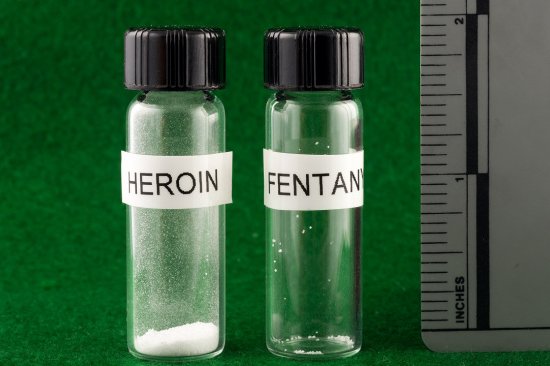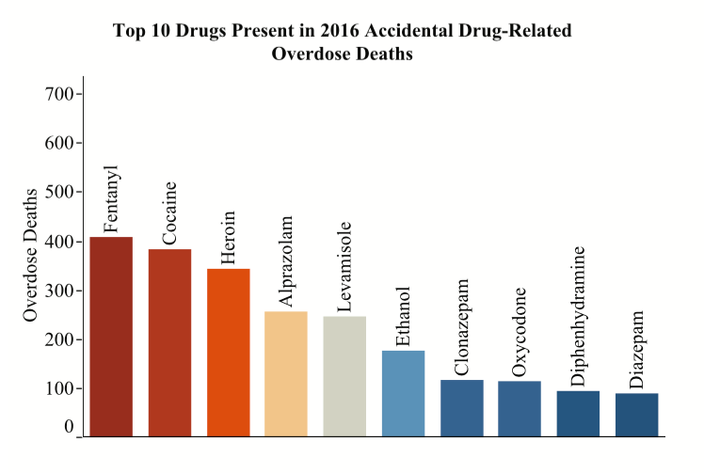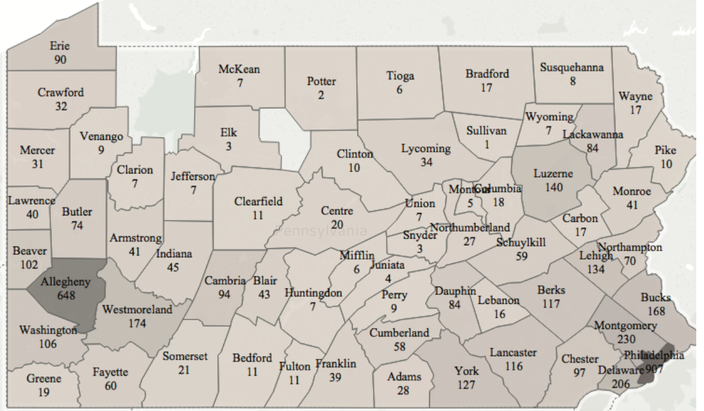
July 27, 2017
 New Hampshire State Police Forensic Laboratory/via PBS
New Hampshire State Police Forensic Laboratory/via PBS
This photo, released last fall by the New Hampshire State Police Forensic Laboratory, shows the amount of heroin needed to match the potency of a smaller batch of fentanyl
As Pennsylvania battles a complex and evolving drug epidemic, sobering new statistics from the Drug Enforcement Administration (DEA) show the state saw a frightening 37 percent increase in drug overdose deaths from 2015 to 2016.
The annual joint intelligence report, compiled with data from coroners and medical examiners across all of Pennsylvania's 67 counties, provides analysis of how patterns of drug use reflect changes in local markets.
Information in the report also aids law enforcement agencies in determining how best to allocate resources and target drug trafficking organizations.
Statewide, a total of 4,642 drug-related overdose deaths were reported by coroners and medical examiners in 2016, a rate of approximately 13 deaths per day.
2016 overdose deaths by county.
| Drug Category | 2016 Overdose Deaths |
| Fentanyl | 2,395 |
| Heroin | 2,089 |
| Benzodiazepines | 1,542 |
| Cocaine | 1,257 |
| Prescription Opioids | 1,181 |
| Ethanol | 918 |
| Other Illicits | 254 |
While the data shows a marked shift from heroin to fentanyl deaths in late 2016, particularly in western Pennsylvania counties, the report notes that a trend cannot necessarily be confirmed by overdose statistics alone. Even so, the surge in popularity of fentanyl is not an aberration — only 27 percent of 2015 overdoses were attributed to the substance — and drug dealers appear to be meeting a demand.
"Because fentanyl is so potent, it can cause a much higher rate of overdose death than heroin, despite lower user rates," the report authors wrote. "Additional indicators reported by law enforcement indicate that users are now seeking out fentanyl instead of unknowingly purchasing fentanyl disguised as heroin, and street-level traffickers are openly marketing fentanyl to customers instead of disguising it as heroin."
Philadelphia, despite dropping from first to fifth in this year's county overdose rankings, has been hard hit by fentanyl and related substances, as shown in the chart below.
2016 Philadelphia overdose deaths by drug.
Overdose numbers in counties across the region all saw increases despite some improvements in state rankings based on deaths per 100,000 people.
| County | Overdose Deaths | % Change |
| Bucks | 168 | 43 percent |
| Delaware | 206 | 1 percent |
| Chester | 97 | 53 percent |
| Montgomery | 230 | 51 percent |
| Philadelphia | 907 | 29 percent |
This year's report comes after a 23.4 percent increase in Pennsylvania overdose deaths was recorded between 2014 and 2015. The 2016 report was prepared in conjunction with the University of Pittsburgh’s School of Pharmacy Program Evaluation Research Unit (PERU) and Technical Assistance Center, which seek to provide context and analysis to public health data.
“Looking at overdose data from counties across the state, we see the devastating effects opioids have on the people of Pennsylvania. Through PERU’s partnerships with the DEA and other community organizations, we are working to do more than analyze numbers,” PERU Director Dr. Janice L. Pringle said. “We strive to provide counties with accurate information and tangible resources that can be implemented to prevent this epidemic from progressing any further.”
 Source/Drug Enforcement Administration
Source/Drug Enforcement Administration